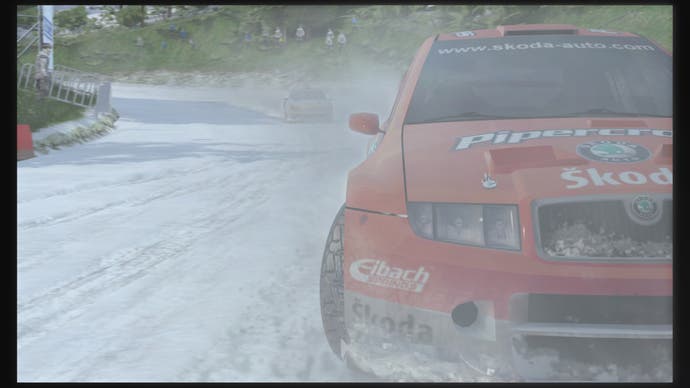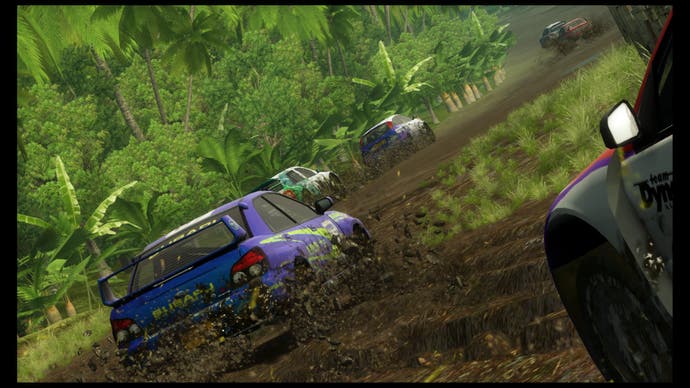SEGA Rally
Guy Wilday talks to us as we play SEGA Rally. A lot.
As with all such things, the key to making a good rally game is wedged in the door marked 'pub'. "You sit late in bars with drivers and co-drivers talking about how these things work," says SEGA Racing Studio boss Guy Wilday. Then you go home and do some programming. So what do rally drivers say? "It's all about tyres, and it's all about surfaces. That really is a key topic of conversation. The cars themselves are obviously very technically innovative, but the thing they focus on is the tyres and the surfaces - what tyres they need for a particular surface, how a car is going to behave on a particular surface, and how that surface is going to change."
It's ironic, in a way, because it was likely Wilday's success working on Codemasters' Colin McRae Rally series that led to his founding the Solihull-based SEGA Racing Studio in the first place, and yet he's just told us that the key to rally driving is changes to conditions that nothing he worked on there - prior to PlayStation 3, Xbox 360 and modern PC hardware - could hope to emulate. The technology simply wasn't around. Well, as they say, it is now. SEGA Rally demonstrates the difference that six rally cars can make tearing across a tightly wound circuit. In fact, surface deformation has such a pronounced effect on gameplay that the game's online, leaderboard-based Time Attack mode will require you to complete three laps and submit an averaged time. "The difference between laps one and three can just be huge."
All this talk of consultation, loose-surface racing, deformation technology and Colin McRae could well send a chill up the spines of SEGA Rally's old guard. As will Wilday's comment that "the remit behind this studio was always to develop content for the Western market". It's not hard to take the things he's saying, add them together and end up with a sort of SEGA Off-Road Gran Turismo. GT's turned into a sort of ASDA trolley dash for motorsport, and sales suggest it's what we want. But surely Racing Studio isn't just going to try and emulate GT's volume factor? "I think there's pressure to do that," he says. "I absolutely agree that Gran Turismo has become a content-based game. It's a fantastic visual showroom of content." But, (phew), "we've been concentrating on creating something very playable that people can latch onto, and not get caught up in the whole content battle."

Surface deformation might sound spoddy, then, but it's sailed in under the aegis of fun. "The original arcade game was groundbreaking; for me it was a milestone in off-road racing. It was really the first game where you really felt in control of a car off-road," Wilday explains. "What we wanted to do here was something else that was new and original that again was going to be another milestone; that was going to be the first game where you actually feel the surface changing and evolving underneath you, and across a number of laps the race is different." At this point it dawns on us that while SEGA Rally 12 years ago couldn't have dreamed of it, in a sense the essence of what surface deformation offers the 2007 vintage is the strongest link between the two games we could've hoped for: the desire to innovate rather than rehash.
Interpretation will only get you so far though (paragraph five, on this evidence). Strapping into a Force Feedback chair with a GT Force steering wheel hooked up to the PlayStation 3 version, and later settling in for a few hours learning each of the four demo circuits in more detail with an identical Xbox 360 build, now we get the chance to put our theories to the test.

Starting with the chair was a mistake, we realise a few hairpin catastrophes later, but SEGA's made few mistakes in the way it's harnessed the technology - something it will also do on the Xbox side with Microsoft's handsome steering wheel. The wheel response, the palpability of the surface changes, and the precarious feel of a rally race are all present and correct. But it's the more concerted exposure we get on the control pad that endears us. Racing against five other humans, or against a mixture of AI racers, we get to tour the three environments (Alpine, Canyon and Tropical - the latter having two tracks on display) and see how the experience develops.
To begin with you're all over the place. It's still fun, but as you clamber up mountain roads, transition into wading through slush and then skating across snow, or glide round sandy turns down by the beach, you throw the back end of the car out too far, you overcorrect on the steering and snag the sides of the track, and you regularly plough straight into the wall at the peak of a hairpin. As you get a better grasp of the relationship between braking, the accelerator, and powerslides, you're able to concentrate on keeping a good line and showing sharp turns a sensible amount of respect, rather than baring your arse to the spectators in blind fear and losing a couple of seconds in the process.

What's interesting though is that the most frustrating thing - smacking walls - starts to disappear from your laps quite quickly. You make mistakes, and they cost you, but the tracks seem to bulge in the places where you make them. It's subtle, and once you've graduated beyond learner lines and started rutting the optimal approach, you won't even notice the run-offs. We put it to Wilday that perhaps they've deliberately designed the tracks to catch newbies when they fall. He laughs. "Motivation from the start was that SEGA Rally's about throwing the car sideways and powersliding round corners, so having the ability to do that is enormously important, so it's quite forgiving. If you make a mistake and go wide on a corner, the penalty is that you've taken a longer line - you're not necessarily penalised by hitting a wall."


